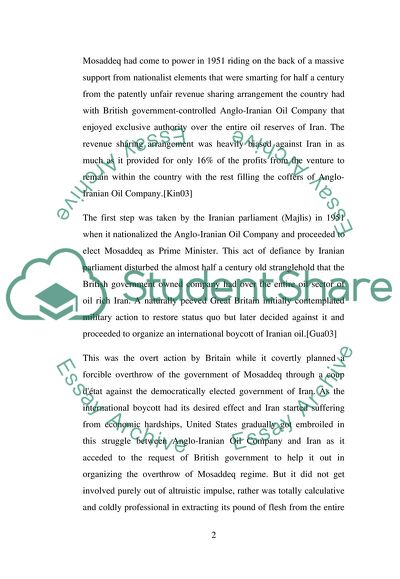Cite this document
(Iranian Reform Movement Case Study Example | Topics and Well Written Essays - 4250 words, n.d.)
Iranian Reform Movement Case Study Example | Topics and Well Written Essays - 4250 words. https://studentshare.org/politics/1729524-the-iranian-current-reform-movement-must-be-from-within-the-country-in-order-to-avoid-the-type-of-blowback-created-by-the-1953-cia-overthrow-both-for-the-legitimacy-of-the-movement-and-the-future-of-us-iranian-relations
Iranian Reform Movement Case Study Example | Topics and Well Written Essays - 4250 words. https://studentshare.org/politics/1729524-the-iranian-current-reform-movement-must-be-from-within-the-country-in-order-to-avoid-the-type-of-blowback-created-by-the-1953-cia-overthrow-both-for-the-legitimacy-of-the-movement-and-the-future-of-us-iranian-relations
(Iranian Reform Movement Case Study Example | Topics and Well Written Essays - 4250 Words)
Iranian Reform Movement Case Study Example | Topics and Well Written Essays - 4250 Words. https://studentshare.org/politics/1729524-the-iranian-current-reform-movement-must-be-from-within-the-country-in-order-to-avoid-the-type-of-blowback-created-by-the-1953-cia-overthrow-both-for-the-legitimacy-of-the-movement-and-the-future-of-us-iranian-relations.
Iranian Reform Movement Case Study Example | Topics and Well Written Essays - 4250 Words. https://studentshare.org/politics/1729524-the-iranian-current-reform-movement-must-be-from-within-the-country-in-order-to-avoid-the-type-of-blowback-created-by-the-1953-cia-overthrow-both-for-the-legitimacy-of-the-movement-and-the-future-of-us-iranian-relations.
“Iranian Reform Movement Case Study Example | Topics and Well Written Essays - 4250 Words”. https://studentshare.org/politics/1729524-the-iranian-current-reform-movement-must-be-from-within-the-country-in-order-to-avoid-the-type-of-blowback-created-by-the-1953-cia-overthrow-both-for-the-legitimacy-of-the-movement-and-the-future-of-us-iranian-relations.


